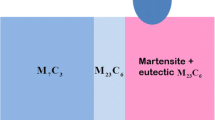Abstract
The preparation of hydroxyl chromium oxide by hydrogen reduction of disodium chromate and particulate hydroxyl mechanical activation features were studied. Then with self-made hydroxyl chromium as the raw material, a direct reduction and carburization process was used to prepare ultra-fine chromium carbonization. Through SEM and XRD, the high performance mechanical activation, key coefficients, microstructure, hardness and wear-resisting property were investigated. The results reveal that suitable mechanical activation and carbon reducing carbonization temperature, carbonization time, carbon content are beneficial to obtaining ultra-fine chromium carbonization. Typically, when the time of high performance grinding is 5 min, the carbon reducing temperature is 1 100 ℃, the carbon reducing time is 1 h, the carbon content is 28%, and finally the particle size of chromium carbide powder is 1 μm. Under this condition of preparation of ultra-fine chromium carbide, both the hardness and wear resistance are better than those in the industrialization of chromium carbide coating.
Similar content being viewed by others
References
Vodop’yanov A G, Serebryakova A V, Kozhevnikov G N. Mechanism of the Interaction of Chromium (III) Oxide with Carbon[J]. Metally, 1979, 35(5): 11–15
Castillejo F E, Marulanda D M, Olaya J J, et al. Wear and Corrosion Resistance of Niobium-chromium Carbide Coatings on AISI D2 Produced Through TRD[J]. Surf. Coat. Tech, 2014, 254: 104–111
Golodov S M, Kolchanov V A, Tarabrin G K. Study of Interaction of Chromium Oxide with Carbon[J]. Metall, 1984, 27(5): 6–9
Ouensanga A. High Temperature Thermodynamic Study of the Reduction of Cr2O3 by Graphite[J]. Z. Metallkd, 1987, 78(1): 70–72
Popov A, Ostrik P N, Gasik M M. Thermodynamics of Reduction and Carbide Formation in the Cr-C-O System[J]. Izv. Vyss. Uch. Zaved. Chrn. Metall, 1986, 29: 1–3
Berger L M, Stolle S, Gruner W. Investigation of the Carbothermal Reduction Process of Chromium Oxide by Micro-and Lab-scale Methods[J]. Int. J. Refract. Met. Hard Mater., 2001, 19(2): 109–121
Zhao Z W, Peng Y B, Yuan H Y, et al. Preparation and Characterization of Chromium Carbide Nanopowders Produced by Carbon Thermal Reduction[J]. Trans. Nonferrous Met. Soc. China, 2012, 22(7): 2005–2009
Reza E K, Hossein M Z, Vahid N. Synthesis of Chromium Carbide by Reduction of Chromium Oxide with Methane[J]. Int. J. Refract. Met. Hard Mater., 2010, 28(3): 412–415
Wang S C, Lin H T, Pramoda K N, et al. Carbothermal Reduction Process for Synthesis of Nanosized Chromium Carbide Via Metal-organic Vapor Deposition[J]. Thin. Solid. Films, 2010, 518(24): 7360–7365
Preiss H, Schultzeb D, Szulzewsky K. Carbothermal Synthesis of Vanadium and Chromium Carbides from Solution-derived Precursors[J]. Eur. Ceram Soc., 1999, 19: 187–194
Zhao Z W, Zheng H J, Wang Y R, et al. Synthesis of Chromium Carbide (Cr3C2) Nanopowders by the Carbonization of the Precursor[J]. Int. J. Refract. Met. Hard Mater., 2011, 29: 614–617
Golodov S M, Kolchanov V A, Tarabrin G K. Study of Interaction of Chromium Oxide with Carbon[J]. Metall, 1984, 27(5): 6–9
Ouensanga A. High Temperature Thermodynamic Study of the Reduction of Cr2O3 by Graphite, Z[J]. Metallkd, 1987, 78(1): 70–72
Antony M P, Vidhya R, Mathews C K. Studies on the Kinetics of the Carbothermic Reduction of Chromium Oxide Using the Evolved Gas Analysis Technique[J]. Thermochim, 1995, 26(2): 145–155
Zhang X F, Fang M X, Tong Y W, et al. Study on Thermodynamic Principle of Preparation of Cr3C2 and Cr by Carbon-heat Reducing[J]. Materials Review, 2010, 24(9): 108–111
Vodop’yanov A G, Serebryakova A V, Kozhevnikov G N. Mechanism of the Interaction of Chromium (III) Oxide with Carbon[J]. Metally, 1979, 35(5): 11–15
Bai Y L. Preparation of Chromium Oxide Clean Technology Research and Optimization of Cryogenic Hydrogen Reduction of Potassium Chromate[D]. Bei**g: Institute of Process Engineering, Chinese Academy of Sciences, 2006
Zhao Z W, Li H G. Influence of Crystal Structure on Mechanical Activation Effect[J]. Trans. Nonferrous Met. Soc. China, 2003, 13(1): 188–194
Wayne M R. Sodium Chromite as a Friction-reducing Material[J]. Wear, 1981, 68(1): 97–107
Antony M P, Vidhya R, Mathews C K. Studies on the Kinetics of the Carbothermic Reduction of Chromium Oxide Using the Evolved Gas Analysis Technique[J]. Thermochim, 1995, 26: 145–155
Zhao Z W, Zheng H J, Zhang S J, et al. Effect of Reaction Time on Phase Composition and Microstructure of Chromium Carbide Nanopowders[J]. Int. J. Refract. Met. Hard Mater., 2013, 41: 558–562
Gomari S, Sharafi S. Microstructural Characterization of Nanocrystalline Chromium Carbides Synthesized by High Energy Ball Milling[J]. J.Alloys Compd., 2010, 490: 26–30
Sharafi S, Gomari S. Effects of Milling and Subsequent Consolidation Treatment on the Microstructural Properties and Hardness of the Nanocrystalline Chromium Carbide Powders[J]. Int. J. Refract. Met. Hard Mater., 2012, 30(1): 57–63
Saduman S. Influence of Chromium Carbide Coating on Tribological Performance of Steel[J]. Mater. Des., 2006, 27(2): 85–91
Author information
Authors and Affiliations
Corresponding author
Additional information
Supported by the National High-tech Research and Development Program of China (863 Program) (No. 2012AA062303), National Natural Science Foundation of China (Nos. 51764016, U1402271, 51504058, 51504059), Jiangxi Science and Technology Landing Project (No. KJLD13046), and the Doctoral Scientific Research Foundation of Jiangxi University of Science and Technology (No. jxxjbs17045)
Rights and permissions
About this article
Cite this article
Tian, L., Chen, L., Zhang, T. et al. Preparation and properties of ultra-fine chromium carbonization of high performance mechanical activation. J. Wuhan Univ. Technol.-Mat. Sci. Edit. 33, 56–63 (2018). https://doi.org/10.1007/s11595-018-1785-0
Received:
Accepted:
Published:
Issue Date:
DOI: https://doi.org/10.1007/s11595-018-1785-0




